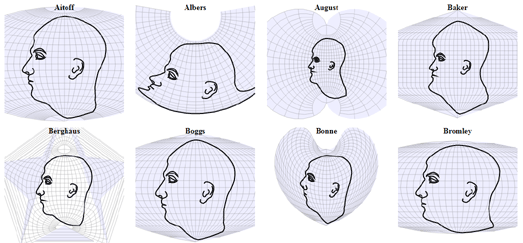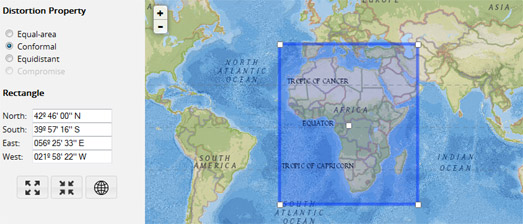Every Map Projection at Once

Overlapping Projections is an interesting map which shows 70 different map projections all at once. The result is a map of the world which is still recognizable but very blurry at the edges.
Overlapping Projections is a simple but effective visualization of how different map projections distort the size of countries around the world. Over the years there have been quite a number of clever interactive demonstrations of how different map projections represent the geography of the world.
Here are a few of my favorite map projection visualizations:

If you are interested in how different map projections distort the world then you will probably like Projection Face. Projection Face is a great illustration of the distortions created by different map projections. The interactive shows how 64 different map projections effect our view of the world by showing each projection's effect when applied to something very familiar - the human face.
The distortions of each of the different projections can be illustrated further by clicking and dragging any of the mapped faces. This illustrates how the different map projections can be distorted themselves simply by changing the center of the map.
Projections Face is an interactive version of a 1924 illustration from Elements of Map Projection with Applications to Map and Chart Construction.

Comparing Map Projections is a clever visualization of different map projections. It allows you to directly compare different types of map projections and see the levels of distortions which each map projection introduces by visualizing a globe in two dimensions.
This interactive visualization provides a useful overview of the advantages and the disadvantages of specific map projections. For
example if you select the much maligned Mercator map projection you can see that it scores very low for angular distortion. This means that all the lines of longitude are straight (compare the vertical lines of longitude on the Mercator projection to those on the Sinusoidal projection). The result is that a Mercator projection is really useful for navigation.
However when you explore the Mercator projection on the Comparing Map Projections interactive visualization you will also see that it has very large overall scale and angular distortion. A consequence of having a very low angular distortion is that the Mercator projection distorts scale (especially the further you move from the equator).
As you can see from Comparing Map Projections all map projections introduce some degree of distortion.
If you want a little help deciding which map projection you should use for your current map project then you can use the Projection Wizard to decide on the best projection.
This map projection guide allows you to select the extent of the map view you are working with by outlining the area on a Leaflet map. Once you've highlighted your map bounds you can choose a distortion property (Equal-area, Conformal, Equidistant or Compromise).
The Projection Wizard will then suggest which map projection you should use depending on the extent and the distortion property of the map. The suggested projections are based on 'A Guide to Selecting Map Projections' by the Cartography and Geovisualization Group at Oregon State University.
A Proj.4 link is provided next to each suggested projection, which opens a popup window with a Proj.4 library. Once you've settled on your map projection you might want to check-out the Proj4Leaflet plugin for using projections supported by Proj4js with Leaflet powered maps.



Comments